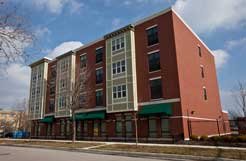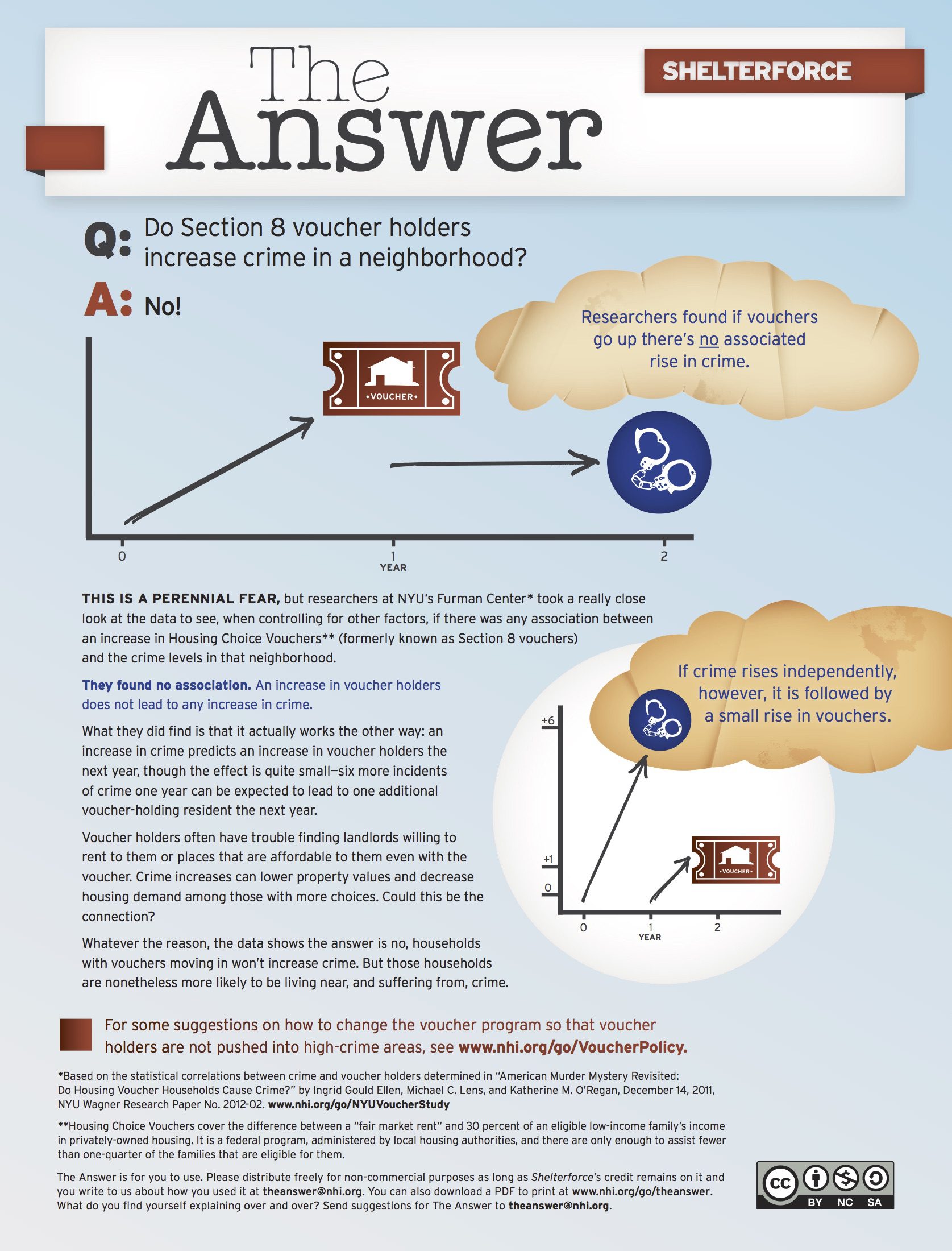
Hope Manor, a supportive housing development for veterans in Chicago, had to find a new site after community opposition. Photo courtesy of Volunteers of America Illinois
“I was absolutely shocked. It was like an ambush.”
The disbelief is clear in Nancy Hughes Moyer’s voice even now, nearly five years after she first faced the full force of community opposition in Chicago. It was February 2010, and the organization she directs, Volunteers of America Illinois, was two weeks away from asking the city council for its vote of approval on a site for Hope Manor, what would become 50 supportive apartments for formerly homeless veterans. What Hughes Moyer and her colleagues had thought would be an easy follow-up meeting with a community group to present finished plans turned into, in her words, “an unfettered disaster.”
Opposition to housing for military veterans can be hard to fathom. Active and retired service members hold a hallowed place in American culture. They greet their families from overseas during Thanksgiving Day football broadcasts. Nearly 30 million people make the pilgrimage to the National Mall in Washington, D.C., each year to visit the war memorials there. But when it comes to our own neighborhoods, it seems many of us simply don’t want a military veteran living next door.
After two years of work to build the support of community members and the local alderman, who ultimately has the final say over new housing development, Hughes Moyer and her staff had been confident. All parties had been supportive, and no significant neighborhood opposition had surfaced. The alderman himself had recommended the long-vacant lot that had been chosen for the site.
But it was clear from the start of this meeting that misinformation and stigma had infected the conversation. A handful of vocal community members had become convinced that the residents of the proposed development would be drug addicts, “crazy people,” and child molesters. No matter what Hughes Moyer and her staff said about the tenant selection plan or the security procedures or the beautiful architecture, these community members had their minds made up. A second community meeting meant to repair the damage produced even worse results. The ensuing two weeks of around-the-clock efforts from Volunteers of America Illinois and city housing staff weren’t enough to salvage the alderman’s endorsement, and the carefully crafted development deal looked to be dead.
But it wasn’t. An alderman from a neighboring ward told the city that if his colleague didn’t want Hope Manor, he would take it. With the support of Alderman Walter Burnett and the extraordinary efforts of city housing staff and Hughes Moyer’s development team, Volunteers of America Illinois was able to preserve all of the funding promised for the original site, and broke ground in West Humboldt Park just eight months after that last disastrous community meeting.
Housing for Veterans: Careful What You Say
As the story of Hope Manor shows, supportive housing for veterans isn’t immune from not-in-my-back-yard opposition. Is this a problem we can solve? Lessons from cognitive linguistics, and best practices in community acceptance, offer hope.
The language we use has a significant impact on perception, but small changes to the way we speak can have a big influence on our chances of success. As housing advocates, we have a way of speaking to one another that’s comfortable and familiar. We cite need data to show the depth of the affordable housing shortage and talk about the area median income or population type our developments are designed to serve. This is fine when we’re speaking to people like ourselves, who “get it.” But these common communication patterns are no match for the stigma and negative perceptions that often meet developers of supportive housing for veterans and others in the greatest need.
[RELATED ARTICLE: What Is NIMBYism and How Do Affordable Housing Developers Respond to It?]
Some residents in Chicago’s West Garfield Park neighborhood heard talk of the Hope Manor proposal and saw a threat. How could neighbors’ perception of what we do be so different from our own? One big reason is frames, the patterns of thinking triggered by words and phrases based on an individual’s past experiences. Terms like “homeless veteran” can activate images of panhandlers, drug addicts, and shelters. These negative frames are nearly impossible to overcome. As Hughes Moyer told me, “You could say ‘homeless former presidents of the United States’ and it wouldn’t matter,” because “homeless” is what people hear. From now on, Hughes Moyer and her staff describe their residents as “veterans at risk of homelessness” or “veterans struggling with housing and employment.” Language like this avoids “otherizing” veterans, and can help audiences see something in common with them: many of us can say we or our family members have struggled with housing or employment, too.
At that first terrible community meeting, Hughes Moyer said that once the “homeless” frame was in peoples’ minds, “everything else we said, they thought we were trying to trick them.” Facts and figures so often backfire for us because negative framing has predisposed our audiences to believing the worst about our work. Our data gets drowned out.
Reach Out Right
Simple changes in language have more power than we often give them credit for, but it’s also essential to structure our community engagement efforts in a way that maximizes our chances of success. This involves thoughtful approaches on the part of the housing developer, as well as from the government entities involved in the process.
Early, one-on-one engagement with influential community members and potential development opponents is critical to preventing and managing conflict. These early conversations can help developers understand and anticipate specific community objections and build allies and goodwill in the community before broader engagement efforts begin. Hughes Moyer shared that since the Hope Manor experience, they’ve made it practice to learn for themselves whose opinion matters in a community and who they need to convince, instead of trusting others to make the right connections for them. Volunteers of America Illinois also works to create partnerships early on with schools and other community organizations. Hope Manor residents volunteer at a nearby school, which gives Hughes Moyer a compelling story to tell about the kind of neighbors her residents will be when she sets out to develop in a new community.
Though often overlooked, there is also a clear role for jurisdictions in building community acceptance. Cities can require community consultation while also making clear that the goal of consultation is to surface concerns and resolve problems, not to give neighbors the ability to veto a development. And strong leadership from elected officials is key, as in truth, broader public policy is involved when it comes to supportive housing for veterans. Since Hope Manor, Hughes Moyer says Volunteers of America Illinois will only move forward with a development if it has active, public support from the local alderman, who in Chicago has the de facto deciding vote.
The politicization of housing development in Chicago and other communities can make for great difficulty as well. If affordable and supportive housing development is truly a priority, jurisdictions should consider putting the final decision on siting and approval in the hands of bureaucrats, not elected officials, so political concerns do not become part of the approval process.
Certainly, even the best development plans can fall victim to the protests of community members or the vicissitudes of the political process. But we should not feel ourselves helpless in the face of community opposition to affordable housing for veterans or any other group. Even the most experienced developers, like Volunteers of America Illinois, can benefit from new approaches to communicating and organizing that can reframe conversations and build a pathway to approval. By building support strategically and keeping our audiences’ points of view at the forefront, we can increase the chance of our own success—and that of the housing community as a whole.





Good advice, but it extends beyond large housing developments. over the decades, I’ve done a lot of work with operators of community residences for people with disabilities to get them through the local zoning process. Fortunately, zoning across the country is not as perverted as it is in Chicago where the alderman essentially has a veto over any development or zoning permits in her ward (a very, very illegal denial of constitutionally-mandated due process).
It is critical to nurture the neighborhood that surrounds your proposed community residence, affordable housing development, or other residential use that departs from the conventional. Neighbors should first hear about it from the operator in the operator’s own language rather from a legal notice or a rumor — both of which can scare the heck out of people. I try to get operators to invite neighbors to coffees where they can get their questions answered. And the invitation should include FAQs in jargon-free plain English as well as an annotated bibliography of studies of the proposed use on property values and neighborhood safety — those are the two primary concerns. Also always be on the look out for underlying racial bigotry at play since neighbors seem to readily understand that the operator will not discriminate against minorities in terms of who lives or works there. The advocates who are telling operators of recovery communities to just move in and ignore the neighbors undermine all people who need these homes.
Wonderful article, Amy. Thank you.
Great insight, great article.